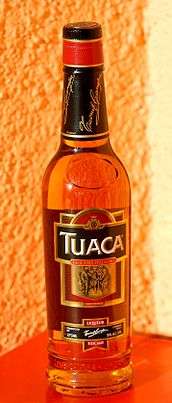Tuaca
Tuaca (Italian pronunciation: [tuˈaːka]) is a naturally flavored brandy liqueur originally produced by the Tuoni and Canepa families of Livorno, Italy. Tuaca is sweet and golden brown in color. Its ingredients include brandy, citrus essences, vanilla, and other secret spices. It is bottled at 70 proof (35% ABV).

History
The brand claims the recipe dates back to the Renaissance period. A legend claims that it was created in the 15th century for Lorenzo the Magnificent and rediscovered by brothers-in-law Gaetano Tuoni and Giorgio Canepa in 1938.[1] The liquor was first created as Brandy Milk, produced with milk, brandy and vanilla.[2] Later on, milk was dropped from the recipe, and the name was changed to Tuoca.
In the 1960s, Mario di Grazia, an Italian and the owner of a chain of liquor stores in San Francisco, began selling the liquor in the United States. After that, in order to make easier the pronunciation in English the name changed again to Tuaca.[3] [4]
Brown-Forman of Louisville, Kentucky acquired Tuaca in 2002 then sold it to Sazerac Company in 2016.
March 31, 2010, marked the closure of Livorno's historic Tuaca plant.
Consumption
Tuaca's mild, sweet flavor makes it popular as a dessert, either on its own (typically chilled) or mixed with coffee, tea, or hot cider.
See also
References
- Tuaca official site
- From the newspaper Il Tirreno, July 14, 2011
- From the newspaper Il Tirreno, October 7, 2012
- "The Webtender". The Webstender. Retrieved 2017-01-20.